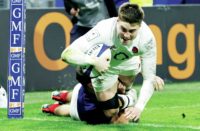 Question: What are the reasons for scrums? I was asked the same question by a friend who currently occupies a high position in the RFU. My response was classically simple: To restart the game after a minor infringement – but of course as a front-row player I know it is much more than that.
Question: What are the reasons for scrums? I was asked the same question by a friend who currently occupies a high position in the RFU. My response was classically simple: To restart the game after a minor infringement – but of course as a front-row player I know it is much more than that.
The scrum is the most potent and complex attacking platform within the game, an area where the individual, specialised talents of eight players combine in an attempt to gain the upper hand in a mental, physical and technical battle.
At the head of that confrontation is the front row, a unit of three who are so technically specialised that they are the only positions on the field that, if they are removed from the game, play cannot continue in its true form.
Those three should work as a team within a team, collectively changing what they do depending on whose ball it is, the position on the field and how the opposition play.
Understanding how and what to do with the myriad of options and potential opportunities that can be created at a scrum is one of the fundamental requirements of a management/coaching team if the players are to exploit those opportunities.
The IRB recognise that scrums are a fundamental structure of the rugby union game and have, over the last few years, tried to give the referee greater control over this complex area of the game.
The latest ‘crouch, bind and set' incarnation would appear to be working, as almost everybody involved in the game seems to have bought into it.
Even the referees had a number of meetings to discuss and agree the application of the laws as written and agreed to try to find consistency in the enforcement of the new scrum engagement call.
This should have ensured that, come scrum-time in these autumn internationals, the scrum controversies of the past few years would have faded away and returned the scrum as a potential attacking weapon.
Despite the fact that there were 17 scrums in the England-Australia match last Saturday, neither team was able to make use of potential opportunities because it seemed that Irish referee George Clancy failed to understand the basic dynamics of the scrum and appeared to come to the game with preconceived ideas as to how Australia would perform.
Now Australia may well have a very poor scrum but that doesn't mean that every scrum infringement during a game is down to them. In fact, the first scrum penalty Clancy awarded against Australia for turning in at the scrum was shown to be totally wrong by a camera view from above.
That view showed that the Australian front row were actually bound and pushing straight – but Mako Vunipola had split from his second row and was driving in at an angle into the side of the Australian tight-head. Add to that, Clancy and his assistants Romain Poite of France and Dudley Phillips of Ireland – both elite referees – seemed unaware that both sides were constantly feeding the ball.
Clancy and his assistants' faux pas were not confined to the scrum, with the most obvious misses being Mike Brown's foot in touch and Dylan Hartley's obstruction.
Much has been written about Brown's foot and the fact that it didn't lead directly to Chris Robshaw's try.
But although there were a number phases of play before the try, there really can't be any argument that the miss indirectly led to England's try.
The difference between running back to a lineout five metres from your line to defend, to attacking the opposition's lineout five metres from their try-line, is immense and, in itself, can be match winning.
At that stage in the game a score either way was decisive, either taking the game beyond England or getting them back in the match.
Sir Clive Woodward's practical suggestion that the back three wear white boots is actually a good idea, as it would probably encourage the referee and the touch judges to call on the TMO if they have even the slightest doubt that a player's toe is in touch.
Hartley's little block could have cost England the victory if TMO Marshall Kilgore had deemed it enough to penalise him and cancel Farrell's try, but fortunately for England, he decided that Hartley's block had obstructed only slightly, so the try was allowed to stand.
The inconsistency in the decisions made by the match officials made it difficult for either team to get into their stride and contribute to what was a very dull game.
From an England point of view a win is a win and despite the poor performance, the character of the team shone through, so onwards and upwards.
So what is the purpose of scrums? The answer given by England's U20s front row during this year's Junior World Championship was: “To win a penalty and that is what we are coached to try to do by the Premiership club coaches.”
With the decisions like those made and missed by the match officials last week, the Premiership coaches are probably right.


























